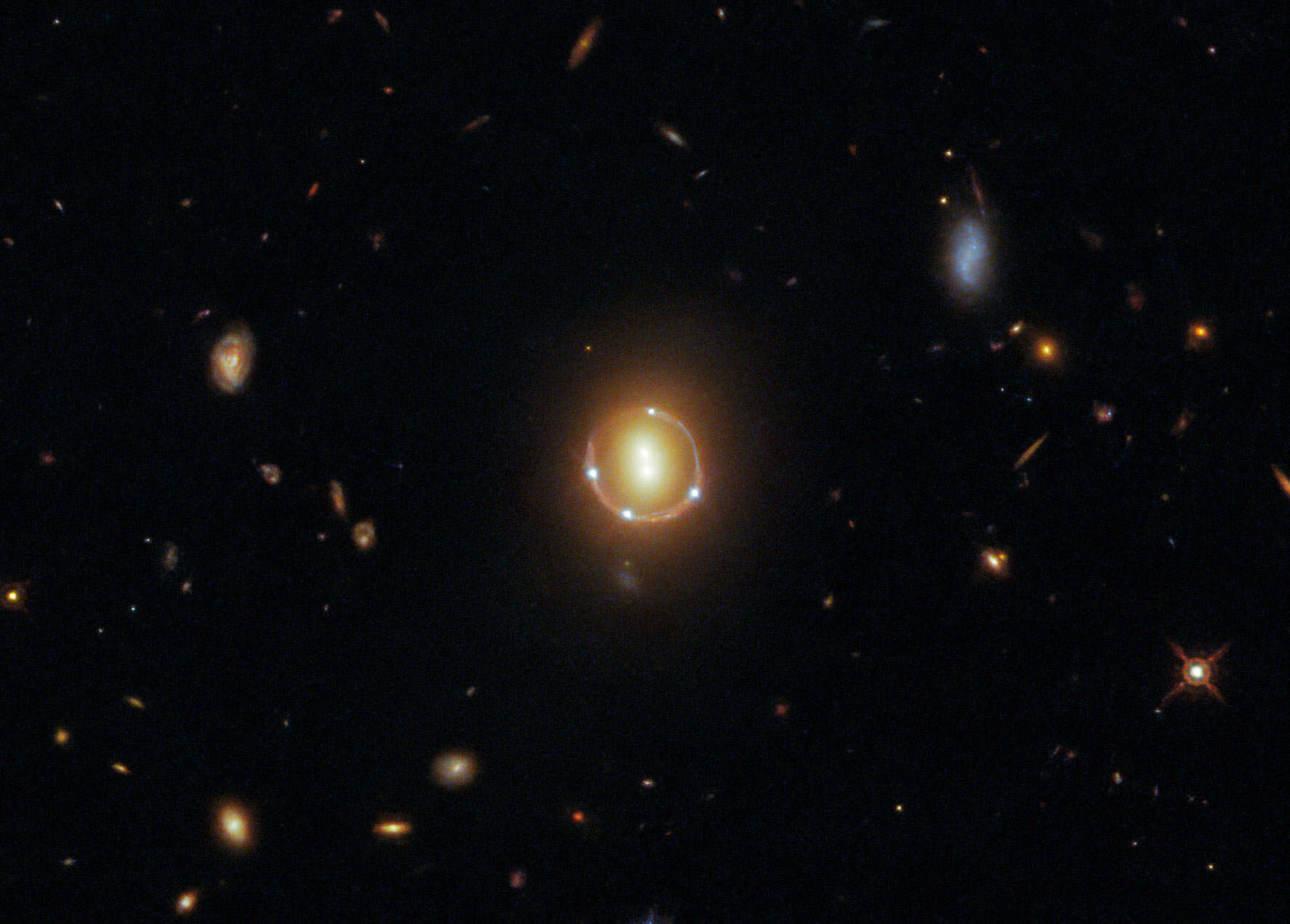Create a free profile to get unlimited access to exclusive videos, sweepstakes, and more!
Hubble spies a quintuple quasar… except it's a cosmic mirage

Peering across the Universe is hard. Happily, the Universe sometimes provides a little help, using gravity to give light a swift kick in the photons.
I'm talking about gravitational lensing:
Briefly, gravitational lensing is when the gravity of a massive object — a star, a black hole, a galaxy — bends space around it, causing light passing by to curve, like a car following the curve of a road. Einstein [wrote about this in relation to his work on Relativity], saying that matter bends space and we perceive this bending as gravity. So we call this gravitational lensing; the object bending space is the lens, and the object whose light is distorted the lensed object.
[...]
Nowadays we've seen this effect countless times. It's a little odd; not only can a lensed object's position in the sky be moved around a little by this effect, but it can also be distorted, stretched out like taffy, even wrapped around the lens like a ring (we call those Einstein rings, in fact), and made far brighter by the lens than it would be otherwise.
Hubble Space Telescope is like a machine designed to observe lensing. It can see small details in faint objects, perfect for this sort of thing. And when it's pointed at a gravitational lens, what you see is just spectacular:
This system is called 2M1310–1714, and was discovered by accident in a survey of galaxies; the survey was designed to get distances for over a million galaxies, and a scientist spotted this lensing situation when he was visually inspecting images of a quarter of a million galaxies. That's… a lot of work. But a dozen lensed systems were found, including 2M1310–1714.
There are two galaxies in the middle that act as the lens itself. They're about 3.4 billion light years from Earth, which is a very long way. But the lensed object is much farther away yet. It's a quasar, a galaxy where the central supermassive black hole is gobbling down matter and lighting it up like a cosmic beacon. The matter heats up as it falls in, and can be so bright we can see it clear across the observable Universe.
And in this case I really mean it: The quasar is a staggering 10.4 billion light years away.
The lensing galaxy pair distorts space around them so much that the quasar light was seriously warped as it passed. The ring is the quasar light smeared out around the galaxies, and the four points along it are also images of the quasar, multiplied and amplified by the pair. There's also a fifth, much fainter, image of the quasar smack dab in the center between the two galaxies as well.
Lensed quasar images are relatively common, but multiples like this very rare. They are also extremely useful: They can be used to figure out how rapidly the Universe is expanding.
The basic idea here is that the quasar light is taking different paths as it passes the galaxy pair, and one path might be slightly longer than another path. Quasars are variable; they can brighten and dim over time, sometimes quite rapidly. If it suddenly brightens, for example, because of those different path lengths we see the lensed images brighten at different times. The images from the longer paths will be delayed compared to the shorter paths. The length of that delay depends on many things, including the exact path the light took, which depends on the distribution of matter in the lensing galaxy pair and, crucially, the distances to the lensing galaxies and the lensed quasar.
We can also measure the redshifts of the galaxies and quasar, which tells us how rapidly the universal expansion is sweeping them away from us. There are a lot of steps in this process, but in the end if you measure the delay between the different lensed images you can measure how rapidly the Universe expands. That is the key measurement we need to understand, well, everything.
The Hubble image was taken to get a good map of the lensing galaxies and the structure of the quasar. With that in hand, big ground-based telescopes can observe it from time to time and look for those changes in brightness. From there, complex mathematical models can be used to measure the warping of space, and from that the cosmic expansion rate. The Hubble image alone can't do that, and the ground-based observations need the ones from Hubble to tighten up the constraints. Together, they are far more powerful than they would be alone.
I love the fact that just all by itself this image would be a real stunner. But when you see the science behind it, and understand that we can understand the most fundamental aspects of the Universe because of it, that amplifies and multiplies my appreciation, too.



























